Farm Musings
The Meaning of $8 Eggs
March 25, 2024
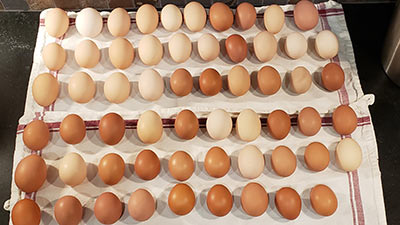 "Eight dollars for a dozen eggs!?!"
"Eight dollars for a dozen eggs!?!"
Yes, our eggs are now priced at $8 per dozen at the Canterbury Country Store and $7 per dozen direct from the farm.
Why? There is no short way to adequately answer this question, so bear with me.
It all starts with the brazen way Big Ag works within our government to unfairly skew laws, practices and federal money toward large industrial food manufacturers. These corporations have worked hand in hand, through their lobbying groups, with federal regulatory agencies and our elected representatives to set up a system in which they receive almost all of the government benefits while producing food and food-like products that are literally making us sick. Farmers…real farmers growing real food... are left with virtually no support and are often met with roadblocks to expanding their market share or opportunities to supply schools and federal food programs with real food. Almost 95% of federal crop subsidies go to growing corn and other grains, oils (soybean, corn), cotton and tobacco. A mere 5% goes to livestock and fruits and vegetables.
I could write for days about the many, many frightening ways our food system has essentially pushed small farmers out of meaningful existence and made trillions of dollars in profits feeding Americans food that makes them sick but a much better source is a book I’ve just finished reading: ‘Food Fix’, by Mark Hyman, M.D. It is not an easy read, a bit of a slog through statistics and economic policy, but the information he puts forth should serve as a rallying cry to those of us who eat food. Which is every one of us. The book came out in 2020, written and edited before the pandemic broke out, so I’m positive the situation with our food system has become even more dire since then. The momentary focus on local farmers as heroes in the panic that cleared store shelves has long been forgotten.
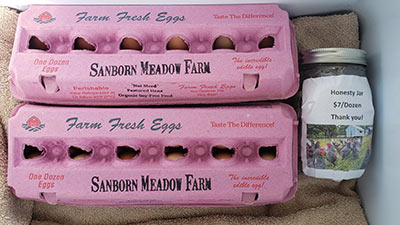 Beyond the government policies and corporate shenanigans that put small farmers at a disadvantage, there are some very basic business principles that work against us. The most obvious of these is economy of scale. Large egg producers, for example, have millions of birds, all stuffed in climate-controlled barns. Feed is bought by the ton, fed automatically. Eggs are carried away from the cages or nest boxes by conveyor belts, run through automatic washers, and packaged by machines into cartons. Billions of eggs are produced in large scale operations that buy birds, feed, equipment, and cartons in bulk at much lower costs than you or I could find. Since the majority of eggs are "conventional" eggs, the feed is cheap, heavily subsidized GMO corn and soy, produced by the manufacturers discussed in the previous paragraphs.
Beyond the government policies and corporate shenanigans that put small farmers at a disadvantage, there are some very basic business principles that work against us. The most obvious of these is economy of scale. Large egg producers, for example, have millions of birds, all stuffed in climate-controlled barns. Feed is bought by the ton, fed automatically. Eggs are carried away from the cages or nest boxes by conveyor belts, run through automatic washers, and packaged by machines into cartons. Billions of eggs are produced in large scale operations that buy birds, feed, equipment, and cartons in bulk at much lower costs than you or I could find. Since the majority of eggs are "conventional" eggs, the feed is cheap, heavily subsidized GMO corn and soy, produced by the manufacturers discussed in the previous paragraphs.
There is no way for a small farmer to compete on price with the big guys. The cheap feed at the big box farm store is more expensive than what the industrial producers are paying. Entering into the organic market offers little relief for the small farmer since the industrial producers have rigged that market as well. Leveraging their economies of scale and influencing the rules governing what practices are allowed under the organic label means they can get away with less expensive practices while adding requirements that are difficult for small farmers to implement without significant and often financially prohibitive investments. Then they charge organic prices to consumers and reap the extra profits.
As if small farmers didn’t have enough to deal with, there is also the huge problem of consumers understanding the true cost of food. We have been so conditioned to seek the lowest cost food which has been artificially cheapened by subsidies and low-cost unhealthy additives. As a nation, we spend the least amount, as a percentage of income, on food at around 6.7%. The next nearest countries are at 8-10% but the middle group of developed countries spends nearly 20%. Supermarkets advertise constantly that "we have the lowest prices!". There is no discussion about the real costs of cheap food, or whether it is in fact FOOD, beyond what you actually pay at the checkout. Here again, I will refer you back to "Food Fix’ for a detailed description of the real costs to our health, our medical system, our communities and our environment from cheap food. Walk into any big box supermarket and you’ll see industrial eggs for less than $3 a dozen. Even after the pandemic, when price-gouging by the egg industry was still rampant, one could find industrial eggs on the cheap, relative to other local options. At those prices, the industrial producers, with their low input and labor costs, are making very healthy profits. The neighbor down the road offering their eggs for $3 a dozen because they have too many isn’t covering their costs, even with the cheap feed from the big box farm store. Their prices are artificially low based on what they see at the supermarket and the perception that their eggs are the same thing, though they may not have done the math to realize it.
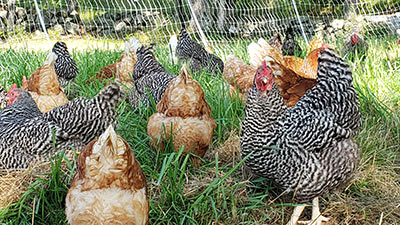 So how do I compete with that? The primary way is by NOT competing directly with industrial eggs. Our eggs are not the same, in any way, including the "organic" and "pastured" eggs you see in the supermarket.
So how do I compete with that? The primary way is by NOT competing directly with industrial eggs. Our eggs are not the same, in any way, including the "organic" and "pastured" eggs you see in the supermarket.
First, our feed is certified organic, sourced exclusively from North America (look up "fraudulent organic grain from Turkey"), and soy-free. It is arguably the most expensive feed on the market, double the price of conventional feed. We’ve done our best to reduce our costs by buying in the largest quantity practicable from our supplier that gets us a tiny price break. Why do we use this feed? Despite my many issues with the USDA organic program, buying certified organic feed is the only current way I can be sure that no GMO ingredients were used, reducing possible glyphosate contamination. I can also have a reasonable expectation that the farmers growing the feed inputs are utilizing practices that preserve and perhaps rebuild our fragile soil, unlike growers of conventional feeds. By choosing soy-free feed, we’ve eliminated in a small way the use of one of the most pervasive monocrops grown in our nation’s most fertile soil. The environmental devastation caused by growing these crops on such a massive scale will soon result in our nation’s breadbasket becoming a desert wasteland. The other reason for eliminating soy in our feed is that soy is not healthy for humans, especially the way it is typically used in the American diet. Soy and soy derivatives are in almost every packaged food product made. Soy is also not healthy for chickens. People with soy allergies or sensitivities to estrogens are concerned about soy proteins and phytoestrogens ending up in the meat and eggs. To me, the benefits to human and chicken health of using organic soy-free feed are worth the extra cost.
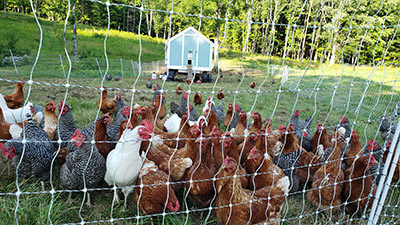 Second, our birds are 100% on pasture. They are rotated on fresh pasture from late March through early December. We move the electric fencing forward every day and move the mobile chicken tractor within the fencing every third day. This means they have fresh pasture, with all the seeds, bugs and vegetation they want to eat, every day, increasing variety in their diet that they wouldn’t have eating only chicken feed in a barn. There is less disease pressure because pathogens don’t build up before the chickens have moved on. They can lay about in the sunshine, flap their wings, chase bugs, dig holes…do all the things chickens are supposed to do but can’t in a barn or closed coop situation. Winters in New Hampshire require a bit more protection than their mobile chicken tractor can offer in open pasture so we bring the tractor over to a more sheltered pasture and attach it to a hoop house filled with deep bedding. The chickens can choose to remain out of the wind and snow but the end of the hoop house is left open so they can also choose to go outside into the fenced pasture. All of these living arrangements require a tremendous amount of labor by us, the farmers. Rotational pasturing means moving electric fencing and chargers daily, moving the chicken tractor often, hauling feed and water daily out to the pasture. Winter maintenance includes adding more bedding and extra cleaning to keep chickens healthy on top of routine daily tasks. As with our choice of feed, the benefits of rotational pasturing are worth the extra effort.
Second, our birds are 100% on pasture. They are rotated on fresh pasture from late March through early December. We move the electric fencing forward every day and move the mobile chicken tractor within the fencing every third day. This means they have fresh pasture, with all the seeds, bugs and vegetation they want to eat, every day, increasing variety in their diet that they wouldn’t have eating only chicken feed in a barn. There is less disease pressure because pathogens don’t build up before the chickens have moved on. They can lay about in the sunshine, flap their wings, chase bugs, dig holes…do all the things chickens are supposed to do but can’t in a barn or closed coop situation. Winters in New Hampshire require a bit more protection than their mobile chicken tractor can offer in open pasture so we bring the tractor over to a more sheltered pasture and attach it to a hoop house filled with deep bedding. The chickens can choose to remain out of the wind and snow but the end of the hoop house is left open so they can also choose to go outside into the fenced pasture. All of these living arrangements require a tremendous amount of labor by us, the farmers. Rotational pasturing means moving electric fencing and chargers daily, moving the chicken tractor often, hauling feed and water daily out to the pasture. Winter maintenance includes adding more bedding and extra cleaning to keep chickens healthy on top of routine daily tasks. As with our choice of feed, the benefits of rotational pasturing are worth the extra effort.
The combination of organic soy-free feed plus rotational pasturing most of the year mean our eggs have a different nutrient profile than the majority of other eggs, store bought or local. The hens eat a more varied diet, including plants and seeds that make for a more nutrient dense egg. They are healthier, have less stress and more room to move around. I challenge you to go to your local supermarket and look at the prices of organic and pastured eggs. The big companies with their economies of scale are charging $7-9 a dozen. Now research how their hens actually live. Like "free range", the term "pastured" has been watered down to mean birds might have access to pasture but it may be for limited hours per day, not rotated on fresh green pasture but a dirt lot, rotated but around a big barn where most of the chickens will hang out day to day. Then look at the feed. If it doesn’t say organic soy-free feed on the carton, then the hens are fed either conventional feed or organic soy-containing feed. Our practices are reflected in the freshness and taste of every egg. We’ve heard "I can’t eat regular eggs anymore" from more than a few customers, which tells us we are on the right path.
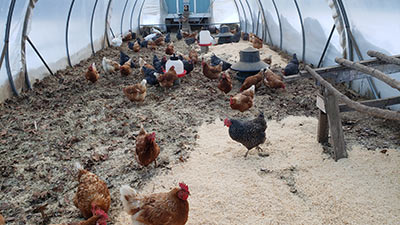 In the end, consumers have choices. Small farmers need to make a living or we will be at the mercy of the large monopolistic companies and their unhealthy food. The reality of those choices is often blurred by fancy labels, slick marketing and deceptive practices. We choose to raise our hens the way we do because we believe our choices matter – to our health, our community and our environment. We are completely transparent about those choices. We believe in a diverse food system, made up of many farmers offering different products locally and consumers making educated decisions about the quality and impact of the food they buy. Our costs are higher because of our choices and the fact that we are not supported by subsidies and do not have any economy of scale. We also choose to sell our eggs directly AND at the local Canterbury Country Store in order to offer our customers the convenience of buying options. Selling eggs on consignment typically means a loss of 25-30% of the retail cost. Wholesale eggs would usually be at 50% of retail cost. We cannot wholesale eggs at our scale as the loss of revenue would be more than we could recover. Consigning eggs is doable but we need to recover that cost where we can and still make enough to have all the hard work we do every day worth it. We are not making huge profits selling eggs. We never have. We’ve been lucky to break even, nearly, if we don’t squint too hard. The harsh reality is we’ve been subsidizing our eggs to our customers for years now because we so strongly believe in the importance of small farms, diverse food systems and better ways of farming for our health and the environment. We are also aware of the problem of higher prices if the consumer doesn’t understand why. Charging $8 per dozen at the store or $7 a dozen direct to consumer from the farm allows us to cover our day-to-day costs for feed, grit, and other supplies, recoup the infrastructure investment (mobile coop, hoop house, electric fencing, etc.) and maybe make a small amount of profit that could be considered a wage for all of our labor 365 days a year.
In the end, consumers have choices. Small farmers need to make a living or we will be at the mercy of the large monopolistic companies and their unhealthy food. The reality of those choices is often blurred by fancy labels, slick marketing and deceptive practices. We choose to raise our hens the way we do because we believe our choices matter – to our health, our community and our environment. We are completely transparent about those choices. We believe in a diverse food system, made up of many farmers offering different products locally and consumers making educated decisions about the quality and impact of the food they buy. Our costs are higher because of our choices and the fact that we are not supported by subsidies and do not have any economy of scale. We also choose to sell our eggs directly AND at the local Canterbury Country Store in order to offer our customers the convenience of buying options. Selling eggs on consignment typically means a loss of 25-30% of the retail cost. Wholesale eggs would usually be at 50% of retail cost. We cannot wholesale eggs at our scale as the loss of revenue would be more than we could recover. Consigning eggs is doable but we need to recover that cost where we can and still make enough to have all the hard work we do every day worth it. We are not making huge profits selling eggs. We never have. We’ve been lucky to break even, nearly, if we don’t squint too hard. The harsh reality is we’ve been subsidizing our eggs to our customers for years now because we so strongly believe in the importance of small farms, diverse food systems and better ways of farming for our health and the environment. We are also aware of the problem of higher prices if the consumer doesn’t understand why. Charging $8 per dozen at the store or $7 a dozen direct to consumer from the farm allows us to cover our day-to-day costs for feed, grit, and other supplies, recoup the infrastructure investment (mobile coop, hoop house, electric fencing, etc.) and maybe make a small amount of profit that could be considered a wage for all of our labor 365 days a year.
It is a make-or-break moment for this part of our farm business. Our community has shown us there is a market for eggs with consumers who care about where their food comes from and how it’s grown or raised. We are hopeful it means that we can continue our mission to bring real food grown with care to our community and contribute to a better food system for all.
Growing Community
February 28, 2024
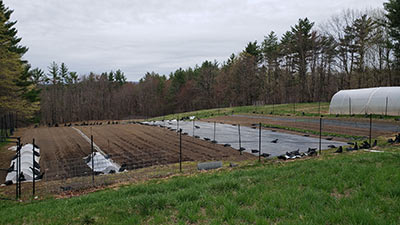 Community gardens have a long history and many variations. From the vacant lot gardens of 1890’s Detroit, the "Victory Gardens" of World War II to the British allotment system, people have found ways to come together and grow food on land that wasn’t necessarily theirs. Growing food to feed themselves was the main goal but often a just as important secondary goal was achieved: growing community. Gardens are a place where the experienced grower and the neophyte can work together, where neighbors who don’t know each other can become fast friends over the tomatoes, and where people can pull a community together to bring much needed food to those in unfortunate circumstances.
Community gardens have a long history and many variations. From the vacant lot gardens of 1890’s Detroit, the "Victory Gardens" of World War II to the British allotment system, people have found ways to come together and grow food on land that wasn’t necessarily theirs. Growing food to feed themselves was the main goal but often a just as important secondary goal was achieved: growing community. Gardens are a place where the experienced grower and the neophyte can work together, where neighbors who don’t know each other can become fast friends over the tomatoes, and where people can pull a community together to bring much needed food to those in unfortunate circumstances.
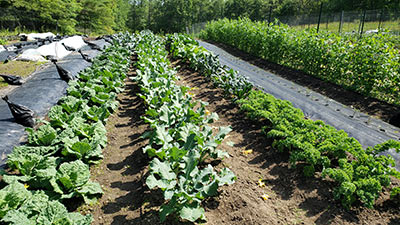 There are many ways to set up a community garden too. The British allotment system rents a strip of land to individuals for the purpose of growing food. One piece of land can have dozens of allotments side by side. Over time, neighbors on adjacent plots get to know each other and a sort of community develops. Each allotment renter grows whatever it is they want or need to grow and tends to their plot themselves. There are community gardens where the group involved choose to grow larger field crops like squash or potatoes that won’t fit readily in their smaller home gardens. They decide to raise only one or two crops and divide the harvest. Church gardens may grow specifically to feed into a local food pantry so they might decide to grow a list of crops the food pantry indicates is needed in that area. I recently read about a large community garden that is run almost like a business. There is a head gardener in charge of the whole thing, committees tasked with certain areas – weeding, planting, harvesting, etc., and an operations center that would rival a military command center. It is owned by a neighborhood association and feeds the entire neighborhood.
There are many ways to set up a community garden too. The British allotment system rents a strip of land to individuals for the purpose of growing food. One piece of land can have dozens of allotments side by side. Over time, neighbors on adjacent plots get to know each other and a sort of community develops. Each allotment renter grows whatever it is they want or need to grow and tends to their plot themselves. There are community gardens where the group involved choose to grow larger field crops like squash or potatoes that won’t fit readily in their smaller home gardens. They decide to raise only one or two crops and divide the harvest. Church gardens may grow specifically to feed into a local food pantry so they might decide to grow a list of crops the food pantry indicates is needed in that area. I recently read about a large community garden that is run almost like a business. There is a head gardener in charge of the whole thing, committees tasked with certain areas – weeding, planting, harvesting, etc., and an operations center that would rival a military command center. It is owned by a neighborhood association and feeds the entire neighborhood.
Last year, I had the crazy idea of getting a group of people together on my farm to grow vegetables in my market garden that we would all use for ourselves and then the extra produce would go the Loudon Food Pantry. The primary goals were to fully utilize my market garden, half of which had spent the previous year under a tarp, grow a bunch of good food, share the labor, and provide some much-needed food for the local food pantry.
Our community garden experiment was much smaller and loosely organized than many of the aforementioned gardens. I invited a group of about 10 friends or friends of friends that I knew from the farmers market or activities in town. We met in January and discussed what we’d like to grow. We wanted all of the usual things: tomatoes, cucumbers, lettuce, etc. but also decided to try some fun things since we had the space. Sweet potatoes were at the top of the "fun" list and an entire row was dedicated to them. Artichokes, celeriac, honeydew melons and spaghetti squash were also on the list as well as lots and lots of green beans. In my years as a market gardener, I learned quickly to winnow down the list of crops I grew to those that generated the maximum sales per square foot, required less daily maintenance or could be turned over quickly to another succession crop. That meant I grew mainly greens – lettuce, spinach, kale, asian greens, chard, plus onions, carrots and basil. In this season, I got to grow winter squashes and tons of peppers, eggplant and shallots, snap peas and oodles of green beans. So many things! And we still didn’t completely fill all 24 rows!
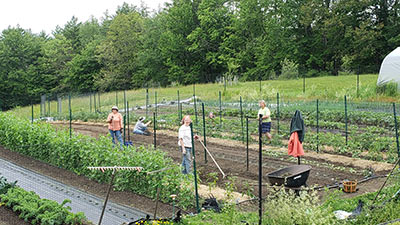 I was the "organizer" and created a schedule of what needed doing each week, plus an updated map of the garden. The season started out strong with everyone pitching in to remove tarps, set up tomato, cucumber and pea fencing, plant and weed. The excitement was palpable. The Loudon Food Pantry indicated that Tuesdays were the best day for fresh produce deliveries so we started harvesting on Sunday or Monday and stored produce in my garden refrigerators. Tuesday mornings became a "all hands on deck" situation to get any greens that needed to go cut and packaged before I delivered everything to the pantry before noon. A stunning amount of food started popping up all over the garden. It was so good to see my market garden fully utilized again.
I was the "organizer" and created a schedule of what needed doing each week, plus an updated map of the garden. The season started out strong with everyone pitching in to remove tarps, set up tomato, cucumber and pea fencing, plant and weed. The excitement was palpable. The Loudon Food Pantry indicated that Tuesdays were the best day for fresh produce deliveries so we started harvesting on Sunday or Monday and stored produce in my garden refrigerators. Tuesday mornings became a "all hands on deck" situation to get any greens that needed to go cut and packaged before I delivered everything to the pantry before noon. A stunning amount of food started popping up all over the garden. It was so good to see my market garden fully utilized again.
As with many "best laid plans", the initial enthusiasm diminished as the season wore on. People dropped out for various reasons and fewer showed up on pantry harvest days. Food was not getting picked and an increasing number of the "to-do" list tasks I put up on the whiteboard each week were being done by me. Now, as someone who is used to gardening full throttle from March to October, I do understand that for everyone else the idea of picking tomatoes in 90-degree heat is less than exciting. It was definitely a situation of expectations vs. reality and my expectations were perhaps a bit high for the collective reality of a group of not-insanely-full-throttle-market-gardener types. I did appreciate those few die-hards who regularly came to the garden to tick off tasks. Because of their efforts, the garden wasn’t overrun with weeds and stayed relatively tidy.
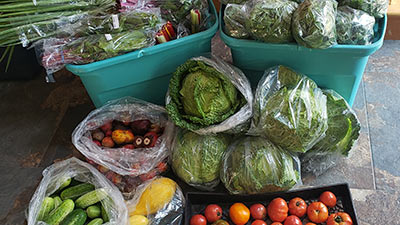 We still managed to pull off a pretty successful garden. We gave almost 700 pounds of produce to the Loudon Food Pantry, although I know we could have easily doubled that. All of us ate very well throughout the season and a few members preserved vegetables in various ways – pickled, canned, frozen. I delighted in looking out my window to see one or more of the members weeding or planting on their own, enjoying the evening air. We had a "potluck garden party" where we each brought a dish made from something we grew in the garden. An afternoon of good food and hilarious conversation, despite the sudden rain storm, made all the hard work worth it. We harvested a bumper crop of sweet potatoes and winter squashes in September and everyone was able to take a good amount home for winter use. Unfortunately, an invading rodent made Swiss cheese out of most of the spaghetti squash and a good number of the peppers but that was our only major crop failure.
We still managed to pull off a pretty successful garden. We gave almost 700 pounds of produce to the Loudon Food Pantry, although I know we could have easily doubled that. All of us ate very well throughout the season and a few members preserved vegetables in various ways – pickled, canned, frozen. I delighted in looking out my window to see one or more of the members weeding or planting on their own, enjoying the evening air. We had a "potluck garden party" where we each brought a dish made from something we grew in the garden. An afternoon of good food and hilarious conversation, despite the sudden rain storm, made all the hard work worth it. We harvested a bumper crop of sweet potatoes and winter squashes in September and everyone was able to take a good amount home for winter use. Unfortunately, an invading rodent made Swiss cheese out of most of the spaghetti squash and a good number of the peppers but that was our only major crop failure.
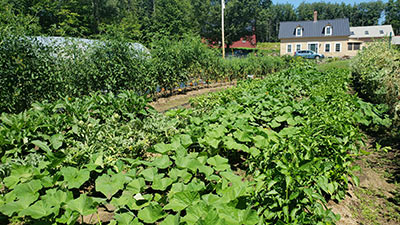 The best part of the whole experiment for me was the mornings when a bunch of us gathered in the garden to harvest or do other work. Conversation flowed easily and we had fun together while enjoying being outside and digging in the earth. That alone was enough for me to have proposed a modified version of our community garden for this year. This time, we will model it more like an allotment system, but without the rent. I will be growing greens to sell at the Canterbury Country Store but will have at least 8 of the 24 rows, each 30 inches wide by 85 feet long, that won’t be needed. Several people have expressed interest in adopting a row as their own to garden as they wish. They have gardens at home but don’t have space for some of the bigger crops. We’ve already decided to go in together on a row of sweet potatoes again as they were such a fun and delicious crop to grow. There is right now a half row planted with garlic by another "adopter". There is only one rule that each adopter is asked to follow: do not let weeds go to seed. Other than that, each has free reign to grow whatever they want. I’m excited to see how it develops.
The best part of the whole experiment for me was the mornings when a bunch of us gathered in the garden to harvest or do other work. Conversation flowed easily and we had fun together while enjoying being outside and digging in the earth. That alone was enough for me to have proposed a modified version of our community garden for this year. This time, we will model it more like an allotment system, but without the rent. I will be growing greens to sell at the Canterbury Country Store but will have at least 8 of the 24 rows, each 30 inches wide by 85 feet long, that won’t be needed. Several people have expressed interest in adopting a row as their own to garden as they wish. They have gardens at home but don’t have space for some of the bigger crops. We’ve already decided to go in together on a row of sweet potatoes again as they were such a fun and delicious crop to grow. There is right now a half row planted with garlic by another "adopter". There is only one rule that each adopter is asked to follow: do not let weeds go to seed. Other than that, each has free reign to grow whatever they want. I’m excited to see how it develops.
I’ll talk more about neighbors growing food together in upcoming projects but there are a few key points I learned last year. First, be clear about expectations. Outline how the garden will work, commitment level, who does what, etc. early on. Second, understand that not everyone is at the same level – of skill or motivation. If that makes you uncomfortable, maybe consider working with those who are closer to your expectations or be willing to be flexible. Finally, consider location. If members have to travel much of a distance to come to the garden, they will be less inclined to make the effort. If you can just walk next door or down the road a piece, you are more likely to get out of the house on a regular basis to work in the garden. There are many more lessons to be learned, but perhaps the most important one might be to not be limited by your current garden circumstances. If you want to grow food, and we all should be thinking about this these days, but your yard or housing situation is not amenable to that, where else could you grow? Your neighbor with the sunny, flat yard? A community center or town building with a large lawn? A vacant lot in your neighborhood? Look around, ask questions and reach out to your neighbors. You might just grow a little community in the process.
Hello Again
February 11, 2024
 Yup. I know it’s been a while.
Yup. I know it’s been a while.
Writing blogs has always been a challenge for me, especially once the season gets going and I’m knee deep in crops and chickens. I put a lot of pressure on myself to write the "perfect" entry each time, with something important and pithy to say. It’s a lot to expect for someone who has never considered herself a writer.
So why do I continue to try? I’m not entirely sure. It’s not as if I’m seeking social media hits in this everything-is-Instagrammable world. I’d rather retreat into my garden with plants than draw attention to myself. I believe part of it is a desire to share what it means to me to be connected to this life of growing and raising food. I believe so strongly that we as a society have lost that connection and are so far removed from where our food comes from. Many great civilizations of the past have fallen not due to losing a war but because they could no longer feed themselves. They’d destroyed the land, overhunted the animals, lost touch with how to work with nature, not against her. We are following the same path. Maybe through sharing my thoughts on farming, I can inspire one person to grow a tomato plant or buy beef from their neighbor’s farm and help revive the local food system we’ve all but erased.
Maybe.
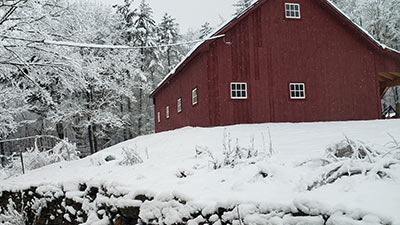
Either way, I want to keep sharing to others and inspiring myself at the same time by creating a record of how this farm has changed in the years we’ve owned it. Some days it feels like I’ve been paddling upstream not getting anywhere but then I look back and realize all I’ve accomplished. I’ve learned so much and I am fortunate to have this opportunity to work this little patch of rocky soil.
 Last year was, as ever, a firehose of chaos on the farm but, despite my frustrations, I came to the end of the year with a bit more clarity about what’s next. Fodder for future blog entries, for sure. I will also attempt to highlight some of the events of last year that shaped how this year will go. I’m hope it will prove interesting. Now February already, I’ve had time to do some fun winter activities and rest a bit. I’m preparing to sow the first seeds under grow lights this week. Spring is rushing toward us, perhaps a bit faster this year with El Nino and Punxsutawney Phil helping out. I’m excited for what the 2024 growing season brings and hope you’ll tag along.
Last year was, as ever, a firehose of chaos on the farm but, despite my frustrations, I came to the end of the year with a bit more clarity about what’s next. Fodder for future blog entries, for sure. I will also attempt to highlight some of the events of last year that shaped how this year will go. I’m hope it will prove interesting. Now February already, I’ve had time to do some fun winter activities and rest a bit. I’m preparing to sow the first seeds under grow lights this week. Spring is rushing toward us, perhaps a bit faster this year with El Nino and Punxsutawney Phil helping out. I’m excited for what the 2024 growing season brings and hope you’ll tag along.